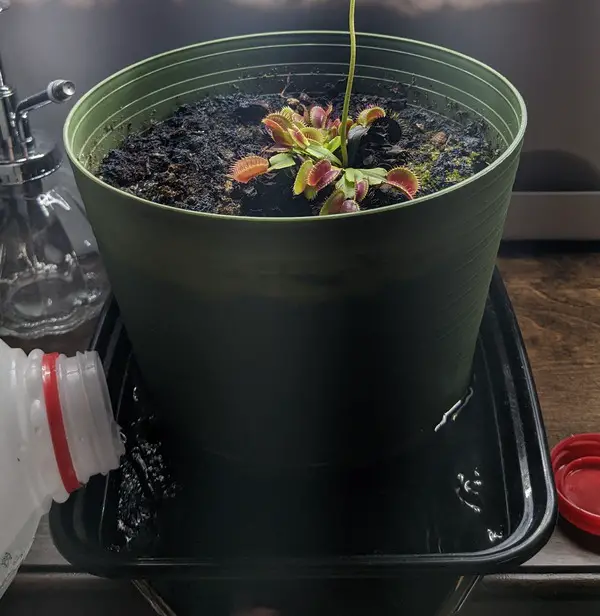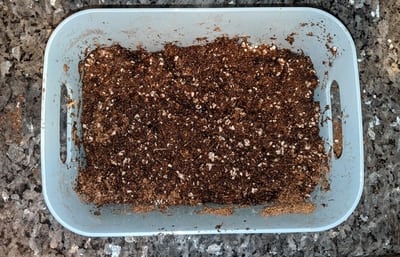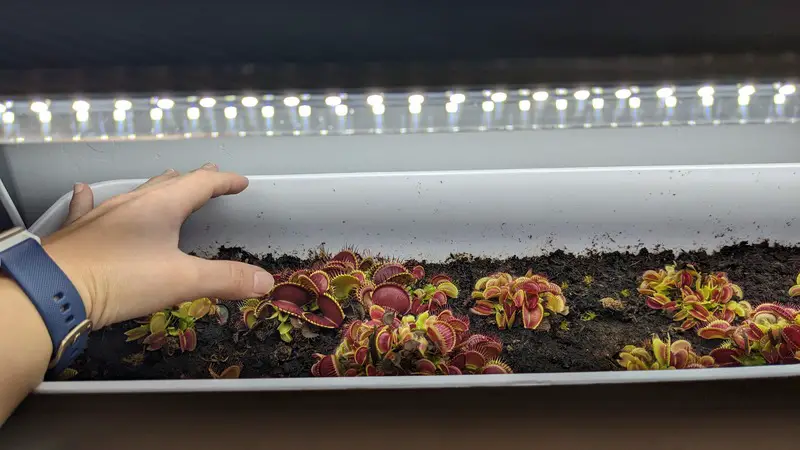I love growing plants at home, but it can be challenging to keep them all healthy. Carnivorous plants are particularly tricky. In this article, we will focus on the fascinating Venus flytrap. We will cover ten hacks on how to keep Venus flytrap alive. Overall, the growing conditions for Venus flytraps should be similar to their native habitat: the wetlands of North Carolina and South Carolina.
Venus flytraps require pure water (distilled or rainwater), carnivorous plant soil, at least 6 hours of direct sunlight, and a humid soil at all times to stay healthy. You should avoid physical stress, overfeeding, and temperatures above 100F or below 20F.
TLDR: Here is a short summary on key Venus fly trap care considerations:
- Water type: Only use distilled, ro or rainwater
- Water frequency: Keep the soil humid at all times
- Soil: Use nutrient-free carnivorous plant soil
- Lighting: Grow under direct sunlight
- Temperatures: Under 95F and over 30F
- Fertilizers: Avoid fertilizing your plant
- Dormancy: Required every winter
- Feeding Menu: Feed your plant insects only
- Stress: Avoid mechanical stress
- Plagues: Check for deformities and pests
- Flowering: Skip the flowering process
Keep on reading to discover all the hacks to keep your Venus flytrap alive.
1- Water with distilled, ro, or rainwater only
Venus flytraps can’t be watered with good all fashion tap water.
Venus flytraps require only nutrient-free, mineral-free water. You have three options; you can water your plant with:
- Distilled water
- Reverse osmosis water
- Rainwater
In nature, Venus flytraps live in a nutrient-free environment. These plants have evolved to survive without nutrients from water or soil. If you water your plant with tap water, your plants won’t be able to handle the nutrients, and eventually, die.
You can buy distilled water or reverse osmosis water in almost any grocery store or pharmacy. Be careful when picking up a bottle. Make sure it doesn’t contain any added components. For example, some pharmacies sell distilled water for small children, but they add some minerals for flavor. The added minerals are not suitable for Venus flytraps.
I would recommend to buy a large water jug and refill it at a water store. It won’t cost more than a few cents per gallon. I live in an area where it doesn’t rain very often. There, it would be impossible to collect enough rainwater. However, if you leave in a rainy climate, feel free to collect rainwater and use it for your plants. It is an economical and eco-friendly option!
If you ever make a mistake and use the incorrect water source, take action immediately. Poor the remaining water out. Then, use a new batch of soil to transplant your Venus flytrap. When the plant is set in the new ground, water it with the correct source. This tip is a critical one. Using the wrong source can kill your Venus flytrap very quickly.
2- Water often; keep the soil humid at all times
Venus flytraps grow in moist soils. They require constant watering throughout their lives. The short advice is: When in doubt, water your plant.

Venus flytraps require a lot of water. The soil should never go dry; it should always contain moisture. The strategy is to water the plants until the ground is damped. Then, you can water again when the soil is moist, but not damp.
It can be challenging to remember watering your plant so often. I use the water saucer strategy for my Venus flytrap. You can place your plant pot on top of a plate full of water. Since the container has openings at the bottom of it, the water of the plate acts as a water reserve. This strategy can keep the soil humid for several days without worrying.
3- Use carnivorous plant soil for potting
Water and soil for Venus flytraps should always be nutrient-free. Improper soil can kill your plants very fast.
Most plants need nutritious soil with some fertilizing now and then.
Venus flytraps can not grow in standard soil since they can’t handle the added elements/nutrients; they require carnivorous plant soil.
You can make this soil by mixing a combination of these components: Long-fibered sphagnum moss, sphagnum peat moss, sand, and perlite.
You can also buy Venus flytrap soil online or at some specialty gardening stores. Some might be labeled as carnivorous plant soil mix or Venus flytrap soil. Generally, make sure it is nutrient-free.
This is an example of an affordable and effective carnivorous plant soil mix you can buy online.
It usually costs less than 10 dollars for a quart. Follow the link to confirm the price on Amazon.com.

Also, once the plant is potted in the appropriate soil, do not fertilize. The fertilizer defeats the purpose of the unique soil mix. Fertilizers can weaken and eventually kill Venus flytraps. Instead of fertilizing, focus on feeding your Venus flytrap properly. More information below.
4- Grow in a bright location (direct sunlight)
Venus flytraps need good lighting year long.
Optimally, they should receive 12 hours of direct sunlight. They can survive under indirect sunlight but will need a few hours a day of direct sunlight to compensate.
Poor lighting won’t kill your plant immediately, but it will start affecting it fast. When growing without proper lighting, Venus flytraps look sluggish. The bright green color characteristic of these plants fades, and the growth rate slows down significantly.
Good lighting is critical. Make sure to place your plant in a sunny window, balcony, or garden. You can also use artificial lighting when natural light is hard to find.
I used to have the perfect window to grow my plants. But I moved, and my new place didn’t have much natural light. The solution was easy: I bought a plant lamp, with a 12-hour timer. With the lamp, my Venus flytraps get all the light they need.
There is a wide variety of suitable plant light options in the market. High Output fluorescent/LED lights are best for Venus flytraps.

Here are a couple of links to some light fictures I used for my Venus fly trap and Sundews.
- Small plant light for 1-4 plants: https://amzn.to/2RsGlxr
- T8 LED light fixture for multiple plants (6500k Cool White): https://amzn.to/3uWoeh2
5- Avoid extreme temperatures (over 100F/ below 20F)
When people look for a sunny spot at home to grow their Venus flytraps, they sometimes forget the environment might get too hot for their plant. In the wild, Venus flytraps are exposed to several months summer with day temperatures averaging 90F without any issues.
You should keep an eye for temperatures that exceed 90F and avoid them.
I live in Arizona. During the summer, temperatures can go over 110F or even 115F. These extreme temperatures are too high for Venus flytraps. Placing them outside without any cover can dry out the plant very fast.
Before placing your plant in a hot area, monitor the temperature.
You should also take into consideration cold temperatures.
Venus flytraps tolerate temperatures in the 30F range. Do not be too worried about freezing temperatures, but avoid letting your plant get buried in snow or frozen completely.
6- Do not apply fertilizers
Venus flytraps are intolerant to nutrients. Applying fertilizers in the soil or in the leaves can end up killing your plant very quickly.
Technically, it is possible to fertilize Venus flytraps, but it is an advance practice. It has to be done very carefully to avoid harming the plant. As a beginner avoid fertilizing your plant, instead make sure your venus fly trap is consuming enough enugh bugs.
7- Ensure your flytrap goes dormant in the winter
Every year, venus flytraps must go dormant during the winter.
Dormancy is a process similar to hibernation. As the temperatures drop below 45 F, venus flytraps enter a dormant state. They stop growing, lose several leaves and look down for several months. Then, once the temperatures start to rise again, the plant will slowly exit dormancy.
Venus flytraps must go dormant for 2-3 months every year to remain healthy. If a venus flytrap skips dormancy for a couple of years in a row it will weaken and eventually die.
To achieve dormancy place your plant in a cold location (under 45 F) for 2-3 months. The reduction in lighting due to shorter days during the winter and the low temperatures ensure your plant goes dormant.
8- Only feed bugs to your plant
Feeding a venus flytrap is an exciting experience. Yet, it can be dangerous for the plant. Inexperienced growers sometimes get excited about the predatory nature of their plants and experiment with an adventurous menu. They feed their plants with human food such as fruit, raw meat, or candy. Venus flytraps have a diverse diet, but their diet focuses on insects and arachnids.
Do not feed your plants with human food. Venus flytraps won’t be able to process such food. Instead, the plant will prefer to let the trap wither. Also, the food remains can attract bacteria into your Venus flytraps.
Stick to an insect/spider-only menu. Venus flytraps eat crickets, beetles, grasshoppers, spiders, slugs, flies, ants, and several other bugs. You can catch bugs to feed your plant. Also, there are a few options in the pet store: dead mealworms, bloodworms, and crickets.
This article covers the feeding procedure in more detail: Venus Flytrap Feeding Guide.
Related Articles:
9- Avoid overfeeding or underfeeding
Venus flytraps produce most of their food through photosynthesis. And they can supplement their diet by consuming insects. If you want to let your plant thrive, you must feed it. Generally, you have two options:
- Place your plant outside: Your Venus flytrap will catch its own prey and stay healthy.
- Place your plant indoors: Your Venus flytrap won’t be able to catch its own prey. You will need to feed it.
Option 1 is very straightforward. Your plant will take care of the feeding. Option 2, however, can be tricky. You must feed your plant with the appropriate frequency. Follow the instructions below to be successful:
- Only feed one trap of the plant at a time
- Only feed bugs that can completely fit inside a trap (insect pieces are an option for small plants)
- Monitor traps that were fed. Verify the bug was consumed. If the trap dies, the prey might have been too big.
- Feed your plant once every 2-6 weeks
- Do not feed your plant during dormancy
10- Reduce stress by unnecessary touching
Just like humans, plants can be affected by stress. However, in this case, we are talking about mechanical stress: movement and continuous handling.
Avoid handling your Venus flytrap when it is not necessary. You can trim dead leaves and feed the plant, but avoid playing with the traps.
Activating the traps is an entirely normal process for the plant. Yet, it can also be very energy-consuming.
When people play with Venus flytrap, they activate their traps and drain the plant’s energy. The stress won’t kill your plant but will weaken it and slow down its growth.
Inanimate objects can also cause stress. Do not place your plant in an area with moving objects such as a window that opens and closes frequently or moving curtains.
Bonus: Check for plagues and treat as needed
Venus flytraps, like most plants, can be affected by several different plagues. The general recommendation is always to keep an eye on your plant behavior. Examine the leaves often and check for any color changes or spots. Each plague has specific remedies, like the ones below:
- Spider mites: use a miticide such as Avid
- Black Spot fungus: use a sulfur-based fungicide
- Aphids: employ pyrethrin or canola oil
“Aphids are the most common pest; the result is twisted and deformed new leaves. They are effectively controlled with insecticides like pyrethrin/canola oil or others (…) Flea collars placed very close to the plant or in an enclosed plastic bag or terrarium work well also. Use the waxy type collars, not the powdery”[1]
Bonus: Prevent your Venus flytrap from flowering
Every spring, Venus flytraps flourish. They produce a few flower bunches thought the spring months. The flowering process is crucial for reproduction, yet, as a beginner carnivorous plant grower, you should skip the flowers during the first years.
Keep close attention to your plant during the spring. As soon as you spot thick cylindrical stalks growing out of your plant, cut them off. By cutting them, you won’t let your plant flower.
The flowering process is not essential for your plant’s livelihood. Instead, it can cause harm. The flowering process is exhausting for Venus flytraps. When they flower, they lose significant amounts of energy.
The flowering process won’t will your Venus flytrap. But, it can weaken them enough so that any growing mistake can kill your plant a lot faster.
Learn more about Venus flytrap flowers with this article: Venus Flytrap Flower Guide
TLDR: Venus fly trap care
Now that you have learned these hacks, I would recommend you to go over the most important care considerations.
This list will help you ensure your set up is optimal! remember, when the conditions are right, Venus fly traps can live for many many years (or decades!) 
Light: Optimally they should receive 12 hours of sunlight, and the minimum is 6 hours of light. The light source might be natural light or artificial lighting (plant lights)
Water: Venus flytraps must be watered with pure water only, such as rainwater, distilled water, and reverse osmosis water. Tap water and bottled water kill carnivorous plants.
The soil of the plant must always remain moist. Always keep the ground humid, but do not flood. Venus flytraps do not grow in swamps.
Soil: Employ nutrient-free soil for carnivorous plants. Never employ enriched soil, full of fertilizers. This article covers many soil options for Venus flytraps.
Feeding: Venus flytraps do not need to capture insects to survive, but they benefit from them greatly. Place Venus flytraps outdoors, and they will have plenty of access to food. Also, consider feeding your plant to provide extra nutrients.
Fertilizers: Do not fertilize Venus flytraps. The chemicals in the fertilizers can hurt the plant
Flowers: After reaching maturity, Venus flytraps start producing flowers every spring. Skipping it allows for further growth and development.
Dormancy: Venus flytraps must undergo a dormancy period for 2-3 months during the winter. Ensure your plant will experience this resting period by placing them in a cold location. For example, outdoors, in a cold garage, or porch.
I hope you have a good growing experience. Venus flytraps are one of the most fun plants to own. Feel free to comment with any questions and additional tips to not only keep Venus flytrap alive but let them thrive.
Good luck!
Sources:
- [1] D’Amato, P. (2013). The Savage Garden. Berkeley, Unites States: Ten Speed Press.
- https://www.sciencedirect.com/science/article/pii/S0022519318300560
Recommended Products for Growing Carnivorous Plants
Finding the best pots, lights, and soil for carnivorous plants is difficult. I have grown carnivorous plants for over 5 years, and these are the products I use. The links will take you to Amazon to view the prices and full specs:
- Carnivorous Plant Soil
- Carnivorous plant soil: https://amzn.to/422yLZa
- Artificial Lighting
- Small plant light for 1-2 plants: https://amzn.to/3oQsmSj
- T8 LED light fixture for multiple plants (6500k Cool White): https://amzn.to/3uWoeh2
- Pots and Miscellaneus
- Nursery pots for single plants: https://amzn.to/3oL8YGq
- TDS meter to measure water quality: https://amzn.to/3g8VKLI
- Dried crickets to feed carnivorous plants: https://amzn.to/34QEnKv

